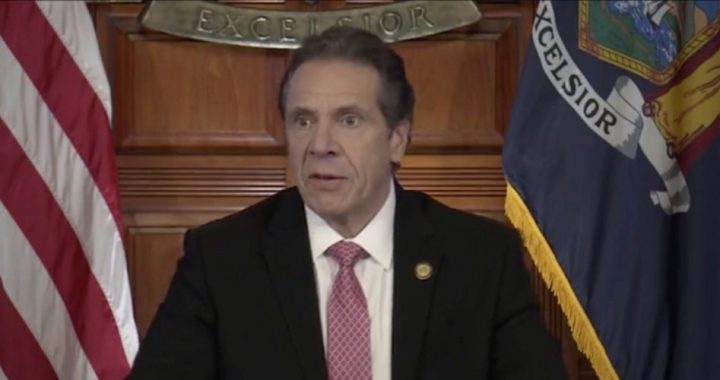
Podcast: Play in new window | Download ()
Subscribe: Android | RSS | More
New York Governor Andrew Cuomo (shown) admitted Thursday that ordering everyone in the state to stay home “was probably not the best public health strategy.”
“We closed everything down. That was our public health strategy. Just close everything, all businesses, old workers, young people, old people, short people, tall people,” Cuomo, a Democrat, said during a press conference. “Every school closed, everything.”
In other words, like many other government officials, Cuomo issued his unconstitutional, economically devastating orders out of panic rather than a rational consideration of medical science and the appropriate limits on governmental power. Now he thinks he may have made a mistake.
“If you rethought that or had time to analyze that public health strategy, I don’t know that you would say quarantine everyone,” Cuomo continued. “I don’t even know that that was the best public health policy. Young people then quarantined with older people was probably not the best public health strategy because the younger people could have been exposing the older people to an infection.”
Asked by the New York Post to elaborate on Cuomo’s remarks, the governor’s office referred to comments Cuomo made Monday.
“There’s a theory of risk stratification that Dr. [David] Katz who’s at Yale University is working on, which is actually very interesting to me,” Cuomo said then. “Isolate people but really isolate the vulnerable people. Don’t isolate everyone because some people, most people, are not vulnerable to it.”
“And if you isolate all people,” he added, “you may be actually exposing the more vulnerable people by bringing in a person who is healthier and stronger and who may have been exposed to the virus.”
Katz, a founding director of the Yale-Griffin Prevention Research Center, penned an op-ed titled “Is Our Fight Against Coronavirus Worse Than the Disease?” that appeared in the New York Times on March 20.
Noting that “as much as 99 percent of active cases in the general population are ‘mild’ and do not require specific medical treatment,” Katz argued governments should be “protecting the truly vulnerable” while allowing the rest of the population to “develop natural herd immunity to the virus.”
“I am deeply concerned that the social, economic and public health consequences of this near total meltdown of normal life — schools and businesses closed, gatherings banned — will be long lasting and calamitous, possibly graver than the direct toll of the virus itself,” Katz wrote. “The stock market will bounce back in time, but many businesses never will. The unemployment, impoverishment and despair likely to result will be public health scourges of the first order.”
The economic consequences of mandated shutdowns are apparently starting to register with Cuomo, too. Earlier in the week, he said that getting the economy going was far less important than maintaining public health. By Thursday, with statistics showing that a record 3.3 million Americans had filed for unemployment the previous week, he had moderated his tone.
“It’s not [that] we’re going to either do public health or we’re going to do economic development and restarting. We have to do both,” he said.
Of course, he still wants to control this process. According to Fox News, “Cuomo said he is working on developing a test which would identify coronavirus antibodies in a healthy person who had recovered from the virus, and after the antibodies showed they had had the virus and it was resolved, they would be able to return to work. Their plasma of antibodies could also be used to treat a sick person and build an immunity to the virus in them.”
Cuomo also pointed to some positive signs. First, he said, New York hospitals are not running out of personal protective gear, though they’re still dealing with the issue on a day-to-day basis. Second, although the number of COVID-19 cases in the state continues to increase each day, the rate of growth is slowing.
That Cuomo is owning up to his mistakes is encouraging, and one hopes officials in other states and cities that have issued similar edicts will come to the same realization soon — and then start lifting their orders. Unfortunately, even if they were all to do so immediately, much damage has already been done to both the economy and liberty.
Photo of Gov. Cuomo: Screen-grab from video on Gov. Cuomo’s Facebook page
Michael Tennant is a freelance writer and regular contributor to The New American.



